
Lupinus sparsiflorus is a species of lupin native to North America. In the United States it occurs in California, Nevada, Arizona and Utah, and in Mexico it is found in Baja California and Sonora. Other common names include Mojave lupine, a name it shares with Lupinus odoratus.
Lupinus adsurgens is a species of lupine known by the common name Drew's silky lupine. It is native to the Sierra Nevada and coastal mountain ranges of northern California and southern Oregon, where it grows in forest and other mountain habitat. It is a perennial herb growing 20–60 centimetres (7.9–23.6 in) in height. Each palmate leaf is made up of 6 to 9 leaflets each up to 5 centimetres (2.0 in) long. The herbage is hairy and silvery or gray-green in color. The inflorescence is up to 23 centimetres (9.1 in) long, bearing flowers just over a centimeter long. The flower is pale pink or purple to yellowish with a white or yellow patch on the banner. The fruit is a silky-haired legume pod 2 to 4 centimetres (1.6 in) long containing 3 to 6 seeds.
Lupinus andersonii is a species of lupine known by the common name Anderson's lupine. It is native to California and adjacent sections of Oregon and Nevada, where it grows in dry mountain habitat of various types. This lupine is similar to Lupinus albicaulis in appearance. It is a hairy, erect perennial herb growing 20 to 90 centimeters in height. Each palmate leaf is made up of 6 to 9 leaflets each up to 6 centimeters long. The inflorescence is up to 23 centimeters long, bearing whorls of flowers each roughly a centimeter long. The flower is purple to yellowish or whitish in color. The fruit is a silky-hairy legume pod up to 4.5 centimeters long containing several seeds.

Lupinus angustiflorus is a species of lupine known by the common name narrowflower lupine. It is endemic to California, where it grows in the volcanic soils of the northeastern mountains and Modoc Plateau. It is an erect perennial herb sometimes exceeding one meter in height. Each palmate leaf is made up of 6 to 9 leaflets each up to 6 centimeters long. The inflorescence is up to 34 centimeters long, bearing many flowers each roughly a centimeter long. The flower is cream to pale yellow-orange with a patch of deeper yellow or orange on its banner. The keeled lower petals may be tipped with lavender. The fruit is a hairy legume pod up to 4 centimeters long.
Lupinus antoninus is a rare species of lupine known by the common name Anthony Peak lupine. It is endemic to northern California, where it is known from only four occurrences in the North Coast Ranges, including near Anthony Peak.
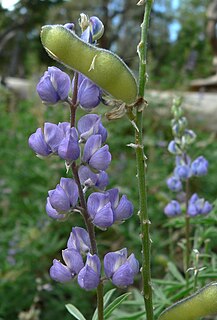
Lupinus argenteus is a species of lupine known by the common name silvery lupine. It is native to much of western North America from the southwestern Canadian provinces to the southwestern and midwestern United States, where it grows in several types of habitat, including sagebrush, grassland, and forests. This is a perennial herb growing erect to heights anywhere between 10 centimetres (3.9 in) and 1.5 metres (4.9 ft). It is sometimes silvery-hairy in texture and sometimes nearly hairless. Each palmate leaf is made up of 5 to 9 leaflets each up to 6 centimetres long. They are narrow and linear in shape, under a centimetre wide. The inflorescence bears many flowers, sometimes arranged in whorls. The flower is 5 millimetres (0.20 in) to 14 millimetres (0.55 in) long and purple, blue, or whitish in color. The banner, or upper petal, of the flower may have a patch of white or yellow. The fruit is a hairy legume pod up to 3 centimeters long containing several beanlike seeds.
Lupinus brevicaulis is a species of lupine known by the common names shortstem lupine and sand lupine. It is native to the southwestern United States and Great Basin area and into northern Mexico, where it grows in many types of sandy habitat. This is a hairy annual herb growing nearly flat in a spread on the ground with a stem just a few centimeters long. An array of leaves encircles the base. Each palmate leaf is made up of 6 to 8 leaflets about a centimeter long and a few millimeters in width. The inflorescence is a petite spiral of flowers a few centimeters long just arising past the basal disc of leaves. Each flower is 6 to 8 millimeters long and bright blue in color, generally with a white or yellowish spot on its banner. The fruit is a hairy legume pod about a centimeter long containing 1 or 2 beanlike seeds.
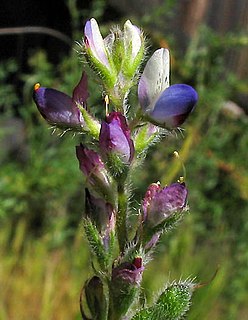
Lupinus concinnus is a species of lupine known by the common name Bajada lupine. It is native to the southwestern United States from California to Texas, and northern Mexico, where it is known from many types of habitat. This is a hairy erect or decumbent annual herb with a stem growing 10 to 30 centimeters long. Each small palmate leaf is made up of 5 to 9 leaflets up to 3 centimeters long and under a centimeter wide, sometimes narrow and linear in shape. The inflorescence is a dense spiral of flowers, with some flowers also appearing in leaf axils lower on the plant. Each flower is 5 to 12 millimeters long and purple, pink, or nearly white in color. The fruit is a hairy legume pod around a centimeter long.
Lupinus constancei is a species of lupine known by the common name The Lassics lupine, or lassicus lupine. It is endemic to California, where it is known from only two occurrences in the Lassic Range in the North Coast Ranges. It is a member of the serpentine soils flora of the mountain forests. This is a low, mat-forming perennial herb no more than 15 centimeters high. Each small palmate leaf is made up of 6 or 7 leaflets up to 2 centimeters long and one wide. The herbage is coated in long, shaggy hairs. The inflorescence is a small, dense clump of several centimeter-long flowers. Each flower is pink in color with darker pink at the tip of the keel. The yellowish banner is reflexed. The fruit is a hairy legume pod 1.5 to 2.5 centimeters long.
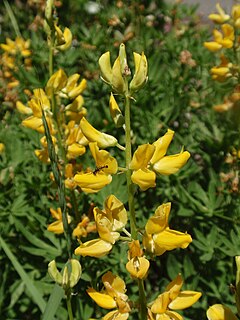
Lupinus croceus is a species of lupine known by the common name saffron-flowered lupine. It is endemic to the northernmost mountains of California, including the Klamath Mountains, where it grows in generally dry, rocky habitat. This is an erect perennial herb growing 40–60 centimetres (16–24 in) tall. The hairy palmate leaves are made up of 5 to 9 leaflets each up to 6 centimetres (2.4 in) long. The inflorescence is a raceme of many flowers, sometimes arranged in whorls. Each flower is just over a centimeter long and bright yellow to orange in color. The fruit is a hairy legume pod up to 3.5 centimetres (1.4 in) long.
Lupinus elmeri is an uncommon species of lupine known by the common names Elmer's lupine and South Fork Mountain lupine. It is endemic to California, where it is known only from a few scattered occurrences in the northernmost slopes of the North Coast Ranges. This is an erect perennial herb with a thick reddish stem and green, hairy herbage. It reaches a maximum height near 90 centimetres (35 in). Each palmate leaf is made up of 6 to 10 leaflets up to 6 centimetres (2.4 in) long. The inflorescence bears pale yellow flowers each roughly a centimeter long which are not arranged in whorls as they are in many other lupines. The fruit is a hairy legume pod up to 5 centimetres (2.0 in) long.

Lupinus flavoculatus is a species of lupine known by the common name yelloweyes, or yellow-eyed lupine.,
Lupinus holmgrenianus is a species of lupine known by the common name Holmgren's lupine. It is native to the desert mountains of western Nevada and a few ranges of adjacent Inyo County, California, including the Last Chance Range of Death Valley National Park. This is a hairy perennial herb growing erect to a maximum height near 70 centimetres (28 in). Each palmate leaf is made up of 4 to 7 leaflets up to 5 centimetres (2.0 in) long. The inflorescence is a spiral of flowers each just over a centimeter long. They are purple in color with yellow patches on their banners. The fruit is a hairy legume pod 4 or 5 centimeters long.
Lupinus hyacinthinus is a species of lupine known by the common name San Jacinto lupine. It is native to the mountains of southern California and adjacent Baja California, where it grows in dry areas, often in pine forests. It is a perennial herb growing erect to a maximum height of one meter. It is hairy in texture, its newer herbage gray-green in color. Each palmate leaf is divided into up to 12 narrow leaflets up to 8 centimeters long and a few millimeters wide. The inflorescence bears whorls of flowers each over one centimeter long. The flower is purple or blue with a white to yellow patch on its banner. The fruit is a silky-haired legume pod 3 or 4 centimeters long containing speckled seeds.
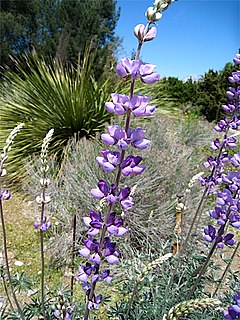
Lupinus longifolius is a species of lupine known by the common name longleaf bush lupine.
Lupinus nevadensis is a species of lupine known by the common name Nevada lupine. It is native to the western Great Basin in Nevada and adjacent sections of Oregon and California, where it grows in sagebrush and other typical basin habitat. It is an erect perennial herb growing 10 to 40 centimeters tall. Each palmate leaf is made up of 6 to 10 hairy leaflets up to 5 centimeters long. The stem and herbage are coated in long hairs. The inflorescence is a spiral of flowers each around 1 centimeter in length. The flower is blue with a whitish patch on its banner and a curved keel. The fruit is a very hairy legume pod up to 4 centimeters long.

Lupinus sericatus is a species of lupine known by the common name Cobb Mountain lupine. It is endemic to the North Coast Ranges of California north of the San Francisco Bay Area, where it grows in the forest, woodlands, and chaparral of the slopes and canyons. It easily colonizes disturbed habitat as well. This is a perennial herb growing up to half a meter tall. Each palmate leaf is made up of 4 to 7 distinctive wide spoon-shaped leaflets each 3 to 5 centimeters long. The inflorescence is a raceme of several whorls of purple flowers, each flower between 1 and 2 centimeters long. The fruit is a hairy legume pod 2 or 3 centimeters long.

Lupinus stiversii is a species of lupine known by the common names harlequin annual lupine and harlequin lupine. The plant was named for Army physician Dr. Charles Austin Stivers, who first collected it in 1862 near Yosemite.
Lupinus tracyi is a species of lupine known by the common name Tracy's lupine. It is endemic to the Klamath Mountains of southern Oregon and northern California, where it grows in coniferous forests. It is a perennial herb growing 20 to 70 centimeters tall and is mostly hairless in texture, with a thin, waxy stem. Each palmate leaf is made up of 6 or 7 leaflets measuring 1 to 4 centimeters in length. The inflorescence is a raceme of many flowers, sometimes arranged in whorls. The flower is around a centimeter long and is pale blue to whitish in color. The fruit is a hairy legume pod roughly 2 centimeters long which darkens as it dries.
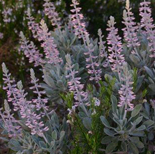
Lupinus aridorum is a rare species of lupine known by the common name scrub lupine. It is endemic to Florida in the United States, where there were 10 known populations remaining in 2003. Fewer than 6000 individual plants were counted. It is threatened by the loss and degradation of its habitat. The scrub lupine is a federally listed endangered species of the United States.












